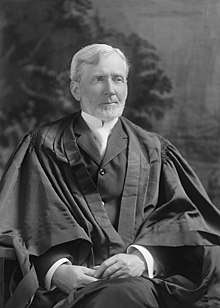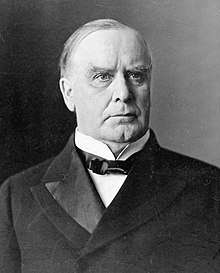Joseph McKenna
Joseph McKenna (August 10, 1843 – November 21, 1926) was an American politician who served in all three branches of the U.S. federal government, as a member of the U.S. House of Representatives, as U.S. Attorney General and as an Associate Justice of the Supreme Court. He is one of seventeen members of the House of Representatives who subsequently served on the Supreme Court (including two Chief Justices).[2]
Joseph McKenna | |
|---|---|
 McKenna in his judicial robes | |
| Associate Justice of the Supreme Court of the United States | |
| In office January 21, 1898 – January 5, 1925[1] | |
| Nominated by | William McKinley |
| Preceded by | Stephen Field |
| Succeeded by | Harlan Stone |
| 42nd United States Attorney General | |
| In office March 5, 1897 – January 25, 1898 | |
| President | William McKinley |
| Preceded by | Judson Harmon |
| Succeeded by | John Griggs |
| Judge of the United States Court of Appeals for the Ninth Circuit | |
| In office March 17, 1892 – March 5, 1897 | |
| Nominated by | Benjamin Harrison |
| Preceded by | Lorenzo Sawyer |
| Succeeded by | William Morrow |
| Member of the U.S. House of Representatives from California's 3rd district | |
| In office March 4, 1885 – March 28, 1892 | |
| Preceded by | Barclay Henley |
| Succeeded by | Samuel Hilborn |
| Personal details | |
| Born | August 10, 1843 Philadelphia, Pennsylvania, U.S. |
| Died | November 21, 1926 (aged 83) Washington, D.C., U.S. |
| Political party | Republican |
| Spouse(s) | Amanda Borneman |
| Education | Saint Joseph's University Columbia University |
Biography
.jpg)

Born in Philadelphia, Pennsylvania, the son of Irish Catholic immigrants, he attended St. Joseph's College and the Collegiate Institute at Benicia, California. After being admitted to the California bar in 1865, he became District Attorney for Solano County and then campaigned for and won a seat in the California State Assembly for two years (1875–1877). He retired after one term and an unsuccessful bid for Speaker.[3]
After two unsuccessful attempts, McKenna was elected to the United States House of Representatives in 1885 and served for four terms. He was appointed to the Ninth Circuit Court of Appeals in 1892 by President Benjamin Harrison.[3]
In 1897 he was appointed the 42nd Attorney General of the United States by President William McKinley, and served in that capacity until 1898.[4] He was then appointed an Associate Justice of the Supreme Court of the United States to succeed Justice Stephen J. Field. McKenna was named by President McKinley on January 28, 1898 and took his seat the next day. Conscious of his limited credentials, McKenna took courses at Columbia Law School for several months to improve his legal education before taking his seat on the Court.
Although he never developed a consistent legal philosophy, McKenna was the author of a number of important decisions. One of the most notable was his opinion in the case of United States v. U.S. Steel Corporation (1920) which held that antitrust cases would be decided on the "rule of reason" principle—only alleged monopolistic combinations that are in unreasonable restraint of trade—are illegal.[5]
McKenna was known to be a centrist, and was one of the most vigorous members of the Supreme Court. He authored 614 majority opinions, and 146 dissenting opinions during his time on the bench. [Bush, Supreme Court Decisions] His passionate rebuttal to the denial of "pecuniary benefit" to a wife whose husband had been killed while working on the railroad was among those which brought a change to the Employer Liability Act. His most noteworthy opinions are Hipolite Egg Co. v. United States 220 U.S. 45 (1911),[6][7] in which a unanimous Court upheld the Pure Food and Drug Act of 1906,
In Hoke v. United States, he concurred in upholding the Mann Act, a/k/a "White-Slave Traffic Act". However, four years later, he dissented from the Court's opinion in Caminetti v. United States (1917), which held the act applied to private, noncommercial enticements to cross state lines for purposes of a sexual liaison. According to McKenna, the Act regulated only commercial vice, i.e., "immoralities having a mercenary purpose." [8]
While McKenna was generally quite favorable to federal power, he joined the Court's substantive due process jurisprudence and voted with the majority in 1905's Lochner v. New York, which struck down a state maximum-hours law for bakery workers,[8] This decision carried broader implications for the scope of federal power, at least until the New Deal and the 1937 switch-in-time-that-saved-nine West Coast Hotel Co. v. Parrish. (See Judiciary Reorganization Bill of 1937.)
McKenna resigned from the Court in January 1925 at the suggestion of Chief Justice William Howard Taft.[9] McKenna's ability to perform his duties had been diminished significantly by a stroke suffered 10 years earlier, and by the end of his tenure McKenna could not be counted on to write coherent opinions.[9]
Justice McKenna was one of 14 Catholic justices (out of the 114 total through the appointment of Justice Brett Kavanaugh) in the history of the Supreme Court.[10]
McKenna married Amanda Borneman in 1869, and the couple had three daughters and one son.[8] McKenna died on November 21, 1926.[8] in Washington, D.C.. His remains are interred at the city's Mount Olivet Cemetery.[11][12]
See also
- List of Justices of the Supreme Court of the United States
- List of law clerks of the Supreme Court of the United States
- List of U.S. Supreme Court Justices by time in office
- United States Supreme Court cases during the Fuller Court
- United States Supreme Court cases during the Taft Court
- United States Supreme Court cases during the White Court
Notes
- "Federal Judicial Center: Joseph McKenna". 2009-12-11. Retrieved 2009-12-11.
- "Members Who Also Served on the Supreme Court". Clerk of the House of Representatives. Archived from the original on November 13, 2017. Retrieved March 14, 2013.
- Joseph McKenna at Archived 2010-03-04 at the Wayback Machine Supreme Court Historical Society.
- Department of Justice, Joseph McKenna Attorney General.
- Joseph McKennat at infoplease.
- Hipolite Egg Co. v. United States syllabus at Justia.com
- Hipolite Egg Co. v. United States full text opinion at Justia.com
- Ariens, Michael, Joseph McKenna at Archived 2010-07-14 at the Wayback Machine michaelariens.com.
- Appel, JM. Anticipating the Incapacitated Justice, August 22, 2009.
- Religious affiliation of Supreme Court justices Justice Sherman Minton converted to Catholicism after his retirement.
- "Christensen, George A. (1983) Here Lies the Supreme Court: Gravesites of the Justices, Yearbook". Archived from the original on September 3, 2005. Retrieved 2013-11-24. Supreme Court Historical Society at Internet Archive.
- See also, Christensen, George A., Here Lies the Supreme Court: Revisited, Journal of Supreme Court History, Volume 33 Issue 1, Pages 17 – 41 (19 Feb 2008), University of Alabama.
References
- United States Congress. "Joseph McKenna (id: M000500)". Biographical Directory of the United States Congress.
Further reading
- Abraham, Henry J. (1999). Justices, Presidents, and Senators: A History of the U.S. Supreme Court Appointments from Washington to Clinton (Revised ed.). Lanham: Rowman & Littlefield. ISBN 0-8476-9604-9.
- Cushman, Clare (2001). The Supreme Court Justices: Illustrated Biographies, 1789–1995 (2nd ed.). (Supreme Court Historical Society, Congressional Quarterly Books). ISBN 1-56802-126-7.
- Frank, John P. (1995). Friedman, Leon; Israel, Fred L. (eds.). The Justices of the United States Supreme Court: Their Lives and Major Opinions. Chelsea House Publishers. ISBN 0-7910-1377-4.
- Hall, Kermit L., ed. (1992). The Oxford Companion to the Supreme Court of the United States. New York: Oxford University Press. ISBN 0-19-505835-6.
- Martin, Fenton S.; Goehlert, Robert U. (1990). The U.S. Supreme Court: A Bibliography. Washington, D.C.: Congressional Quarterly Books. ISBN 0-87187-554-3.
- McKevitt, Brother Matthew (1946) Joseph McKenna: Associate Justice of the United States.
- Urofsky, Melvin I. (1994). The Supreme Court Justices: A Biographical Dictionary. New York: Garland Publishing. pp. 590. ISBN 0-8153-1176-1.
External links
| Wikisource has original text related to this article: |
| Wikimedia Commons has media related to Joseph McKenna. |
- Department of Justice, Joseph McKenna Attorney General.
- Joseph McKenna at Find a Grave
- Joseph McKenna at Supreme Court Historical Society.
- Official Supreme Court media, Joseph McKenna at the Oyez project.
| California Assembly | ||
|---|---|---|
| Preceded by James Dixon William H. Northcutt W. S. M. Wright |
Member of the California Assembly from the 19th district 1875–1877 Served alongside: Thomas M. Swan |
Succeeded by John T. Dare Richard C. Haile |
| U.S. House of Representatives | ||
| Preceded by Barclay Henley |
Member of the U.S. House of Representatives from California's 3rd congressional district 1885–1891 |
Succeeded by Samuel Hilborn |
| Legal offices | ||
| Preceded by Lorenzo Sawyer |
Judge of the United States Court of Appeals for the Ninth Circuit 1892–1897 |
Succeeded by William Morrow |
| Preceded by Judson Harmon |
United States Attorney General 1897–1898 |
Succeeded by John Griggs |
| Preceded by Stephen Field |
Associate Justice of the Supreme Court of the United States 1898–1925 |
Succeeded by Harlan Stone |


